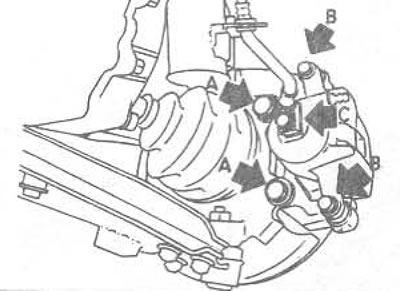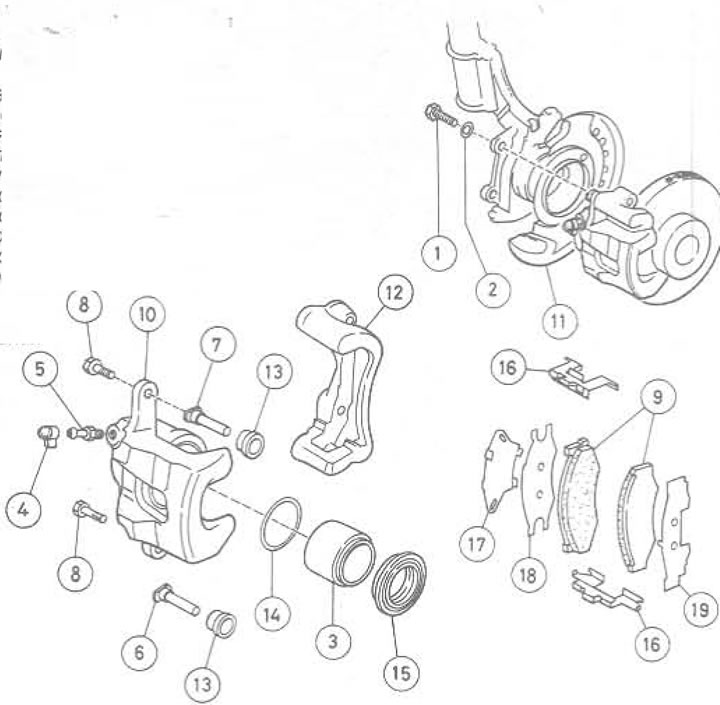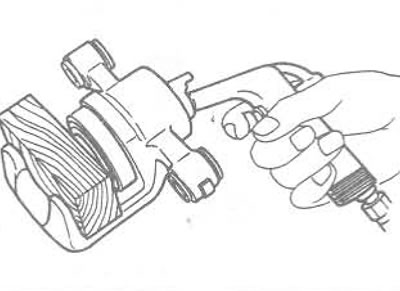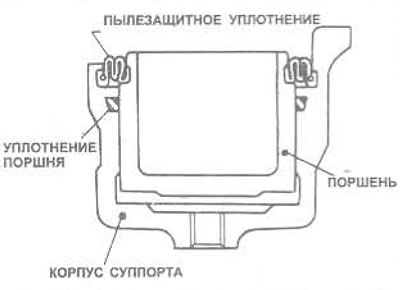Note: Before starting work, please read the Note at the beginning Chapter 12.
Checking the caliper action
1. If damage occurs to the brake system (car pulls to the side when braking), the front brake calipers can be checked as follows.
2. Place the vehicle on a level surface, apply the handbrake and block the rear wheels. Loosen the wheel nuts, jack up the front of the car and support it on axle stands. Remove the wheel.
3. Remove the brake pads, then place a steelyard against one of the wheel stands and measure the torque of the hub bearing. This measurement must be within the specified range, record the measurement as force "A".
4. Install the brake pads and caliper housing, press the brake pedal several times until the pads are installed, then press the brake pedal and hold the pressure for 5 seconds. Release the pedal, rotate the brake disc 10 full turns and measure the wheel bearing torque again; record the measurement as a force "IN".
5. Subtract "A" from "IN". If the result is greater than 103N, remove the caliper as described below to check the wear of the caliper guide pins. Replace them (and rubber dust caps), if they are worn or damaged, or clean and lubricate them. Also check the brake pads.
6. Repeat measurements as described above. If the calculated brake grip has not decreased, then the caliper piston is stuck or the piston seal is bad.
Caliper bulkhead
7. Place the vehicle on a level surface, apply the handbrake and block the rear wheels. Loosen the wheel nuts, jack up the front of the car and support it on axle stands. Remove the wheel.
8. To limit fluid loss, remove the master cylinder reservoir cap and cover it with plastic, or clamp the flexible hose with a G-clamp or similar tool.
9. Clean the area around the connection (photo), unscrew the banjo bolt connecting the flexible hose ('C' in fig. 9.15). Remove the two sealing gaskets.

Pic. 9.15. Front brake caliper mountings: A Bolts securing the caliper to the hub fastening element; B Guide pin bolts; With Banjo Bolt Connection Flexible Hose

14.9. Clean the connection in front of the flexible hose from the front brake caliper - LH on the connection identifies the left caliper hose
10. Loosen both caliper guide pin bolts, unscrew the lower guide pin bolt, and rotate the caliper body upward.
11. Remove the brake pads, shims and anti-rattle springs.
12. Unscrew the upper guide pin and disconnect the caliper body from the suspension. Remove the guide pins. Remove the rubber dust cap from each guide pin.
13. Unscrew the caliper suspension from the hub fastening element.
14. Place a small block in the caliper jaws and remove the piston, including the dust seal.
15. Remove the dust seal from the piston, remove the piston seal from inside the caliper cylinder.
16. Assembling the caliper is carried out in the reverse order.

Pic. 9.16. Front brake caliper view: 1. Bolt; 2. Washer; 3. Piston; 4. Dust cap; 5. Branch pipe; 6. Bottom guide pin; 7. Upper guide pin; 8. Guide pin bolt; 9. Brake pads; 10. Caliper body; 11. Brake disc shield; 12. Caliper suspension; 13. Rubber dust cap; 14. Piston seal; 15. Dust seal; 16. Anti-rattling spring; 17. Gasket; 18. Gasket; 19. Gasket
17. Place the caliper body onto the suspension, install the brake pads, install the guide pin bolts, and tighten them with the tightening torque specified in the Specifications.

Pic. 9.17. Blowing out the caliper piston with compressed air
18. Check the fluid level in the master cylinder reservoir, add if necessary. Install the wheel and lower the car.

Pic. 9.18. Correct installation of caliper piston seal and dust seal
19. Repeat the procedure described on the opposite caliper - always touch both calipers at the same time.